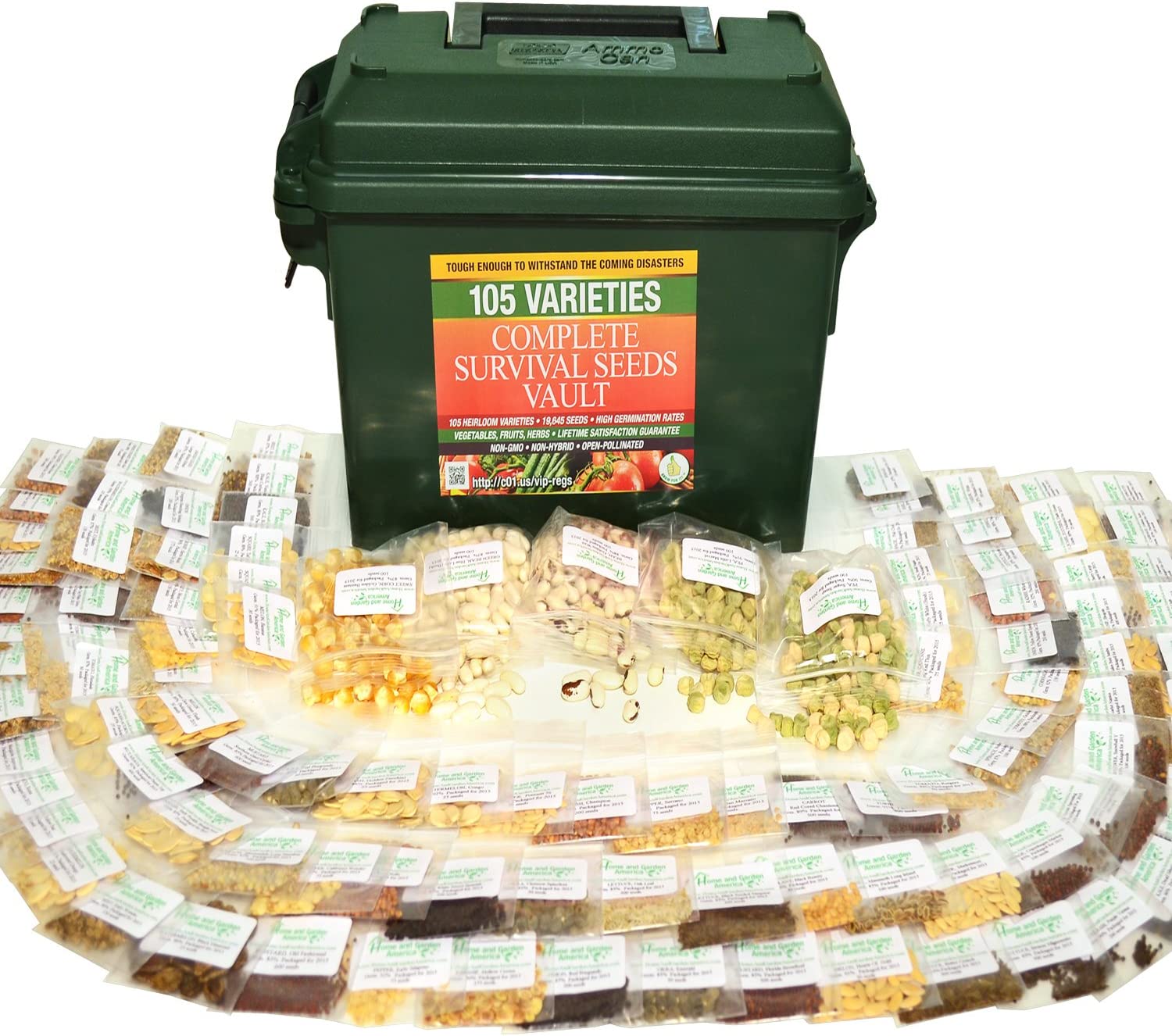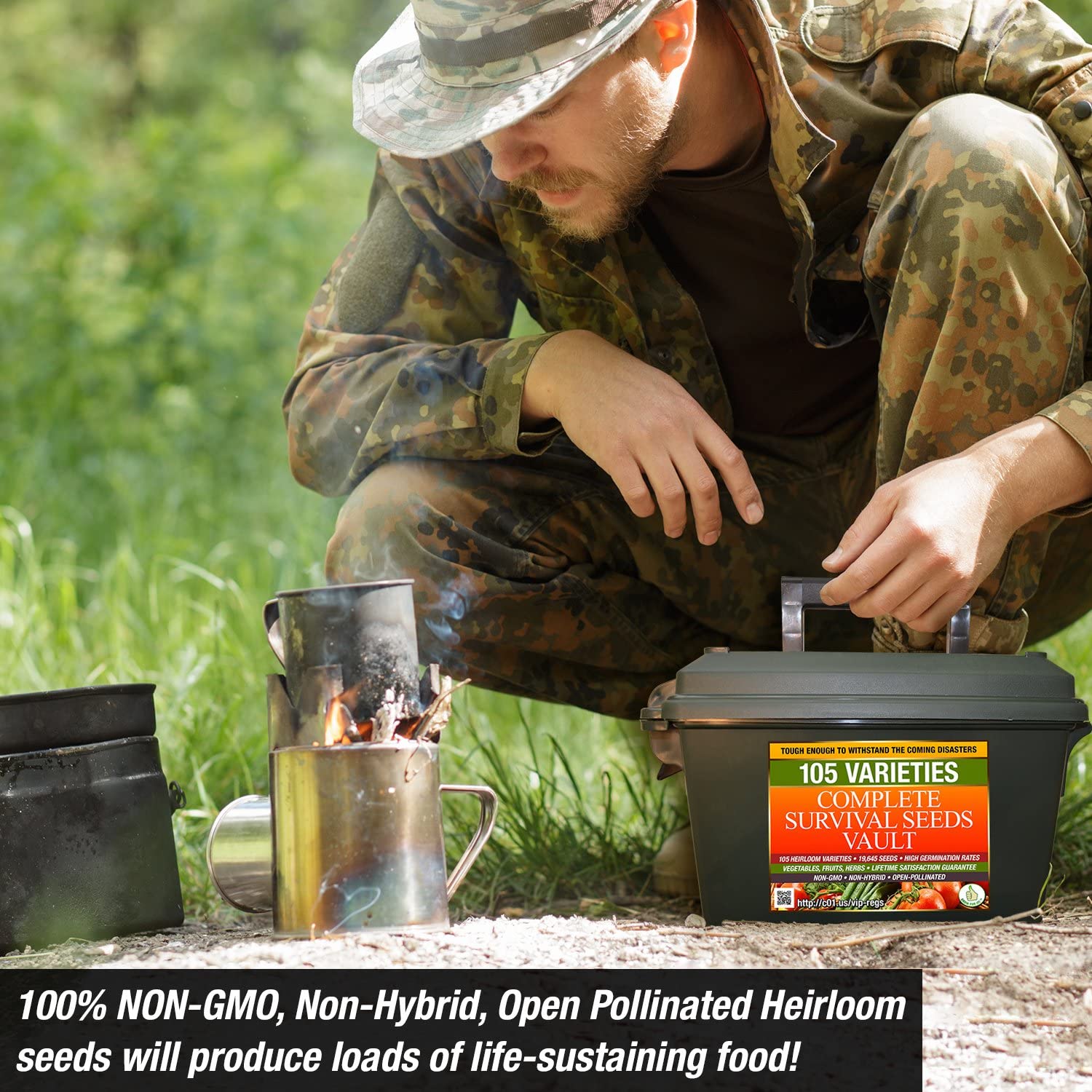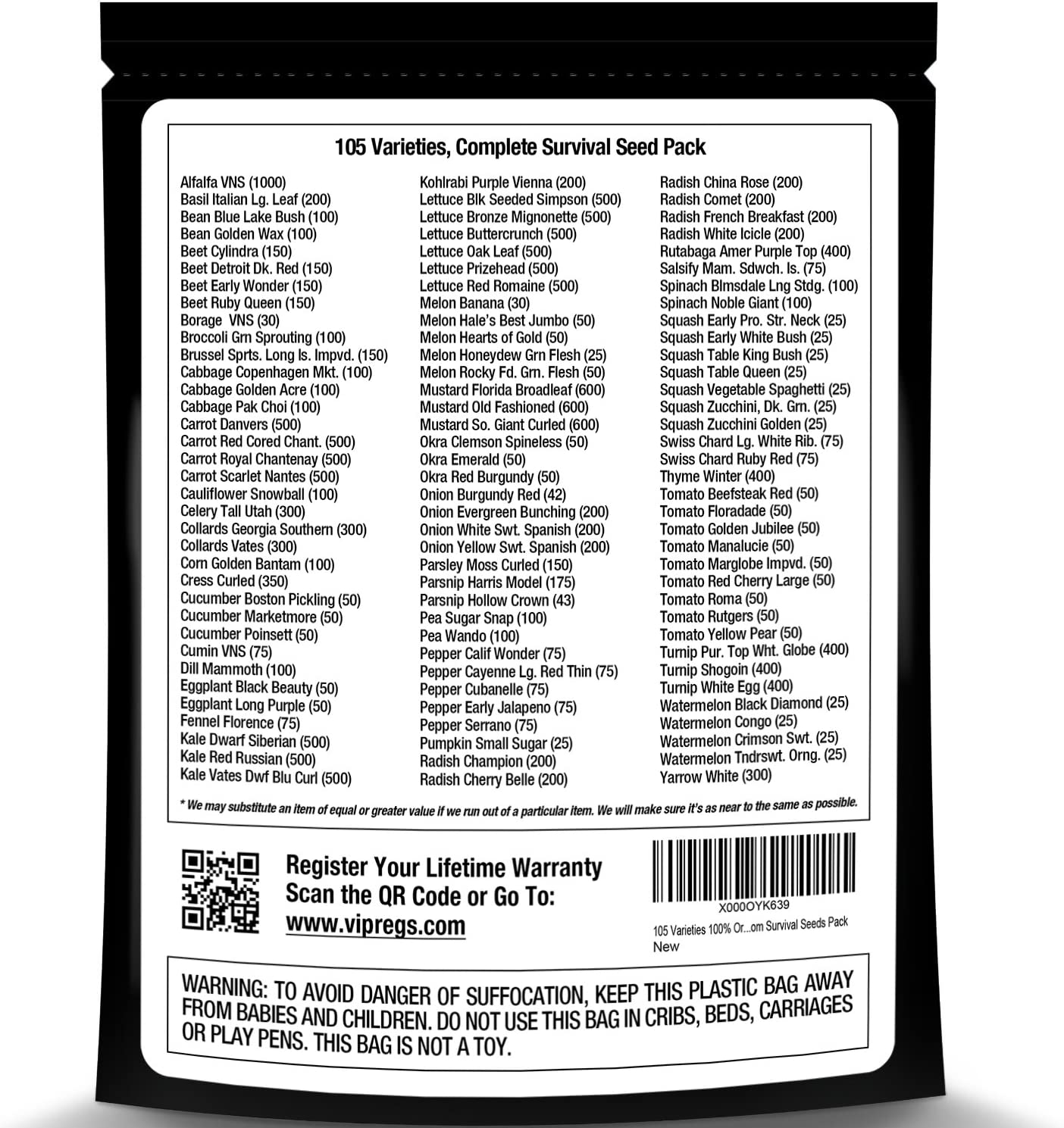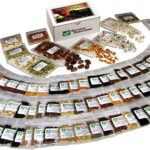
When you’re gearing up for urban survival, your strategy must include securing a reliable food source. Non-GMO survival seed kits are your ticket to sustainability and self-reliance. Let’s dive into why these seeds are a must-have in your urban prepper arsenal and which kits are the best choice for you.
Key Takeaways
Non-GMO seeds are essential for urban preppers due to their purity and sustainability.
Compact seed kits are ideal for small spaces and balcony gardens.
Heirloom varieties offer long-term benefits and can be harvested for seeds.
Proper storage and care ensure seed longevity and viability for future planting.
Investing in a quality seed kit is a cost-effective way to secure your food supply.
Thrive with Non-GMO: The Urban Prepper’s Seed Selection
As an urban prepper, you might wonder why non-GMO seeds are the go-to choice for your garden. It’s simple: they’re pure, they haven’t been tampered with genetically, and they produce plants just like their parent. This means you can save seeds from your harvest and replant them year after year, ensuring a perpetual food supply. Plus, non-GMO seeds are known for their robustness in various growing conditions, making them perfect for the unpredictable urban environment.
Essential Factors for Seed Kit Success
When choosing your urban prepper seed kit, there are a few key factors to consider:
Variety: Look for kits that offer a wide range of vegetables, fruits, and herbs to ensure a balanced diet.
Quantity: The number of seeds should be sufficient for multiple planting seasons.
Germination Rate: High germination rates mean more successful sprouts and less waste.
Packaging: Seeds should be well-packaged to protect against moisture and pests.
Instructions: Clear planting and harvesting instructions are vital, especially for beginners.
Remember, the goal is to have a continuous supply of food, so diversity and quantity matter.
Most importantly, you need to think about your unique urban space. Not everyone has a backyard, but that doesn’t mean you can’t grow your own food. Balcony gardens, window boxes, and even indoor grow systems can all be part of your urban prepper plan.
Why Non-GMO Seeds Triumph in Urban Survival
Non-GMO seeds are not just a choice; they’re a statement. By choosing these seeds, you’re supporting agricultural diversity and taking a stand against the monopolization of food sources. They are adaptable, hardy, and, most importantly, they ensure that you are eating the healthiest produce possible. Because in a survival situation, your health is your greatest asset.
Growth in Tight Spaces: Best Seed Kits for the Urban Prepper
Space is a premium in urban settings, but that shouldn’t stop you from growing your own survival garden. The best seed kits for urban preppers are designed with space constraints in mind. They include varieties that can be grown in pots or containers, require less soil, and can thrive with limited sunlight.
Top Compact Kits for Small-Scale Gardening
When space is limited, every inch counts. Here are some of the top compact seed kits that pack a punch in small spaces:
Survival Garden Heirloom Seeds Non GMO – 105 Varieties
Urban Leaf Window Garden Seed Starter Kit
Spade to Fork Indoor Herb Garden Starter Kit
These kits are curated to maximize your yield in minimal space and come with a variety of plants that are easy to manage. For those looking to start their own survival garden, the Survival Garden Heirloom Seeds Non GMO – 105 Varieties is a great option.
Take the Survival Garden Heirloom Seeds Non GMO – 105 Varieties, for example. This kit is a powerhouse of diversity, offering over a hundred types of seeds, all non-GMO and heirloom, ensuring that you can grow a vast array of produce even in the most cramped city apartment. You can buy this product with confidence, knowing that it’s specifically designed to meet the needs of urban preppers like yourself.
Container Gardening Champions: Seed Varieties that Thrive on the Balcony
Not all plants are created equal when it comes to container gardening. You’ll want to select seed varieties that are known to perform well in pots and other confined spaces. Here are some champions of the container garden:
Cherry Tomatoes: Small but prolific, perfect for hanging baskets.
Lettuce: Shallow roots make it ideal for window boxes.
Herbs: Most herbs are well-suited to small pots and can grow indoors.
Peppers: Both sweet and hot varieties can flourish in containers.
Radishes: Fast-growing and compact, radishes are excellent for quick harvests.
Each of these varieties can turn a small balcony into a lush, edible garden that’s not only functional but also visually appealing.
Remember, the key to a successful urban garden is starting with the right seeds. With the right kit, you can transform any space into a survival food haven. Stay tuned for more tips on how to nurture your garden and ensure a bountiful harvest, even in the heart of the city.
Harvesting Sustainability: Longevity and Storage of Seed Kits
Ensuring the longevity of your seed kits is crucial. After all, a prepper’s garden isn’t just for a single season – it’s for continuous and reliable food production. Seeds, if stored properly, can last for years and become a vital resource in times of need.
One of the biggest enemies of seed viability is moisture. Excess humidity can invite mold and bacteria, which can ruin your seeds before they even hit the soil. To prevent this, keep your seeds in a cool, dry place. Airtight containers are your best bet, and some preppers go the extra mile by adding desiccant packets or vacuum sealing their seed packets.
The Art of Saving Seeds: Techniques for Future Harvests
Future harvests depend on your ability to save seeds from your plants. Heirloom varieties are especially valuable because they produce seeds that will yield a similar plant year after year. Here’s how to do it right:
Let your healthiest plants go to seed instead of harvesting them.
After the seeds have matured, collect them and let them dry completely.
Label your seeds with the variety and date of collection.
Store them in a cool, dry place away from direct sunlight.
By following these steps, you’re not just growing plants; you’re cultivating a legacy of sustainability for years to come.
Maintaining Viability: Storage Tips for Max Seed Longevity
Here are a few more tips to ensure your seeds stay viable for as long as possible:
Temperature Stability: Avoid storing seeds in places where the temperature fluctuates, like a garage or attic.
Moisture Control: Use silica gel packets to absorb any moisture that might be in your storage container.
Light Avoidance: Keep seeds in a dark place, as light can trigger some seeds to use up their stored energy.
Rodent Protection: Make sure your storage area is secure from mice and other critters that might see your seeds as a tasty snack.
With these practices, your seed bank will be a well-spring of life, ready when you need it.
From Seed to Security: Setting Up Your Urban Garden

Transforming seeds into a thriving urban garden is an empowering step towards self-sufficiency. It starts with choosing the right location. Your garden needs to receive ample sunlight – at least 6 hours a day. Next, consider the soil. If you’re working with containers, a high-quality potting mix is essential. For those with a bit of yard space, testing and amending your soil will give your plants the best chance to flourish.
Step-by-Step Guide to Starting an Urban Prepper Garden
Here’s how to get your urban garden off the ground:
Choose your location: Find a spot with good sunlight and access to water.
Select your containers: If you’re tight on space, any container will do, as long as it has drainage.
Prepare your soil: Use a mix of compost, potting soil, and perlite for aeration.
Plant your seeds: Follow the instructions for planting depth and spacing.
Water wisely: Keep the soil moist but not waterlogged.
Monitor and maintain: Watch for pests and diseases and handle them promptly.
With these steps, you’ll be on your way to harvesting your own food in no time.
Maximizing Yield in Limited Space: Innovative Planting Strategies
To get the most out of your urban garden:
Go vertical: Use trellises and hanging baskets to take advantage of vertical space.
Practice succession planting: After one crop is harvested, immediately plant a new one.
Interplanting: Grow compatible plants together to maximize space and nutrients.
These strategies can help you grow a variety of crops, even in the smallest of spaces.
The Green Investment: Cost and Quality Considerations

Investing in quality seed kits is an investment in your future. While the upfront cost might be higher than buying a few packets at the local store, the long-term benefits are immense. Not only do you get a wider variety of plants, but you also get the assurance of non-GMO, heirloom-quality seeds that can become the foundation of your food supply.
Seed Kit Cost Breakdown: What’s a Good Deal?
Here’s what you can expect to spend on a quality seed kit:
Basic kits can range from $30 to $50 and usually include a variety of common vegetables.
Mid-range kits may cost between $50 to $100 and offer a wider selection, including herbs and fruits.
Premium kits, like the Survival Garden Heirloom Seeds Non GMO – 105 Varieties, can cost upwards of $100 but provide an extensive range of seeds that can cover all your dietary needs.
Remember, it’s not just about the number of seeds, but the quality and variety they offer.
Quality vs. Quantity in Seed Selection: Striking the Right Balance
While it’s tempting to go for the kit with the most seeds, quality should be your top priority. Heirloom, non-GMO seeds are more likely to give you the robust crops you need for true food security. A smaller selection of high-quality seeds is better than a vast quantity of inferior ones.
Ultimately, your urban prepper seed kit should be tailored to your needs and growing conditions. By choosing wisely and caring for your seeds, you’re not just growing plants – you’re nurturing a future of abundance and security.
FAQs are a goldmine of quick info, and as a prepper, you’ve got questions that need answers. Let’s address those concerns and arm you with the knowledge to make your urban garden a stronghold of sustainability.
Can I Really Rely on Non-GMO Seeds for a Complete Diet?
Yes, you can! Non-GMO seeds can provide a diverse range of nutrients when you select the right mix of vegetables, fruits, and herbs. Think tomatoes rich in vitamin C, leafy greens packed with iron, and herbs full of antioxidants. It’s all about balance and variety, and with the right kit, you can grow a garden that contributes significantly to a healthy, complete diet.
How Do I Choose Seed Kits for Unpredictable Urban Climates?
Urban climates can be tricky, but the key is to look for seed varieties known for their resilience. Opt for seeds that can withstand a range of temperatures and don’t require long periods of direct sunlight. Many kits are designed with versatility in mind, offering plants that can adapt to changing conditions. Also, consider kits that include season extenders like cold frames or greenhouse plans to protect your crops.
Look for “urban” or “city” garden collections that cater to small spaces and variable climates.
Choose kits with a mix of early, mid, and late-season varieties to extend your harvest period.
Consider companion planting to naturally protect your plants from pests and climate extremes.
Remember, a little research goes a long way in finding the perfect seed kit for your urban oasis.
Are There Edible Plants That Even a Beginner Can’t Mess Up?
For sure! Some plants are just naturally hardier and more forgiving, perfect for those just getting their green thumbs. Radishes, for instance, grow quickly and don’t need much attention. Herbs like basil and mint are also great starters—they’re useful and can be grown indoors. Lettuce and spinach are other easy wins for the beginner gardener. Start with these, and you’ll be harvesting your own food in no time.
What’s the Real Shelf Life of a Non-GMO Seed Kit?
The shelf life of a non-GMO seed kit can vary, but most seeds will remain viable for at least 2-3 years if stored correctly. Some seeds, like beans and peas, can last even longer. The key is proper storage—cool, dark, and dry. With the right conditions, you might be pleasantly surprised at how long your seeds can last.
But don’t just store them and forget them; regular rotation is vital. Plant and replenish your stock to keep your seed bank fresh and ready for whatever comes your way.
How Can I Secure My Seed Investment Against Pests and Diseases?
Securing your seeds means being proactive. Start with disease-resistant varieties to give your garden a fighting chance. Use natural pest deterrents like marigolds and keep your garden clean to prevent infestations. If you’re storing seeds, make sure the containers are airtight and consider adding a few bay leaves to ward off insects.
It’s also smart to have a diverse garden. If one plant succumbs to pests or disease, it won’t take down your entire food supply. Diversification is not just a financial principle; it’s a prepper’s best practice for garden security.
For those living in the city, creating a survival garden may seem challenging due to space constraints and lack of soil. However, with the right knowledge and tools, urban dwellers can effectively grow their own food, ensuring a sustainable supply of fresh produce even in times of uncertainty. By selecting the appropriate non-GMO survival seed kits and utilizing innovative urban gardening techniques, you can maximize your yield in even the smallest of spaces.







Leave a Reply